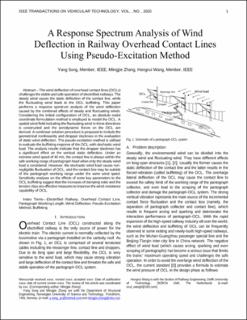| dc.contributor.author | Song, Yang | |
| dc.contributor.author | Zhang, Mingjie | |
| dc.contributor.author | Wang, Hongrui | |
| dc.date.accessioned | 2021-10-21T12:53:35Z | |
| dc.date.available | 2021-10-21T12:53:35Z | |
| dc.date.created | 2021-05-19T10:09:34Z | |
| dc.date.issued | 2021 | |
| dc.identifier.issn | 0018-9545 | |
| dc.identifier.uri | https://hdl.handle.net/11250/2824544 | |
| dc.description.abstract | The wind deflection of overhead contact lines (OCLs) challenges the stable and safe operation of electrified railways. The steady wind causes the static deflection of the contact line, while the fluctuating wind leads to the OCL buffeting. This paper performs a response spectrum analysis of the wind deflection caused by the combined effects of steady and fluctuating winds. Considering the initial configuration of OCL, an absolute nodal coordinate formulation method is employed to model the OCL. A spatial wind field including the fluctuating wind in three directions is constructed and the aerodynamic forces on the OCL are derived. A nonlinear solution procedure is proposed to include the geometrical nonlinearity and dropper slackness in the evaluation of static wind deflection. The pseudo-excitation method is utilised to evaluate the buffeting response of the OCL with stochastic wind load. The analysis results indicate that the dropper slackness has a significant effect on the vertical static deflection. Under an extreme wind speed of 40 m/s, the contact line is always within the safe working range of pantograph head when only the steady wind load is considered. However, the stochastic wind load causes non-negligible fluctuation of OCL, and the contact line may be outside of the pantograph working range under the same wind speed. Sensitivity analyses on the effects of some key parameters to the OCL buffeting suggest that the increases of damping ratio and the tension class are effective measures to improve the wind-resistance capability of OCL. | en_US |
| dc.language.iso | eng | en_US |
| dc.publisher | Institute of Electrical and Electronics Engineers (IEEE) | en_US |
| dc.title | A Response Spectrum Analysis of Wind Deflection in Railway Overhead Contact Lines Using Pseudo-Excitation Method | en_US |
| dc.type | Peer reviewed | en_US |
| dc.type | Journal article | en_US |
| dc.description.version | acceptedVersion | en_US |
| dc.rights.holder | © IEEE. Personal use of this material is permitted. Permission from IEEE must be obtained for all other uses, in any current or future media, including reprinting/republishing this material for advertising or promotional purposes, creating new collective works, for resale or redistribution to servers or lists, or reuse of any copyrighted component of this work in other works. | en_US |
| dc.source.journal | IEEE Transactions on Vehicular Technology | en_US |
| dc.identifier.doi | 10.1109/TVT.2021.3054459 | |
| dc.identifier.cristin | 1910689 | |
| cristin.ispublished | true | |
| cristin.fulltext | postprint | |
| cristin.qualitycode | 2 | |
